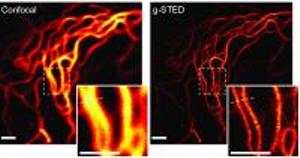An agreement has been signed by Leica Microsystems with the German Cancer Research Center (DKFZ) and the Max Planck Society for the manufacture of sophisticated super-resolution stimulated emission depletion (STED) microscopy.
 Protein keratin is marked with the fluorescent protein Citrine in a living PtK2 cell.
Protein keratin is marked with the fluorescent protein Citrine in a living PtK2 cell.
According to the agreement, Leica Microsystems receives an authorization for developing the novel gated STED technology and introducing it commercially.
Stefan Hell, Director of Biophysical Chemistry at the Max Planck Institute has achieved a major milestone by introducing new features in conventional STED microscopy to discover this gated STED microscopy technology. The contrast and resolution is considerably enhanced in the gated STED technology when compared to the continuous-wave stimulated emission depletion (CW-STED) microscopy. The intensity of laser is also comparably decreased by this new technology. The live cell capacity and photostability are improved, which extends the application range of the new microscopy. It will be possible to use STED fluorescence correlation spectroscopy (STED-FCS), in more number of applications while using gated STED technology. The gated STED technology will be mainly used to observe the movements of molecules in living cells.
Leica Microsystems is planning to launch the new super-resolution STED microscope within the first six months of the year 2012. The previously existing Leica TCS CW-STED confocal systems and Leica TCS SP5 will be upgraded using the modular concept of gated STED technology.